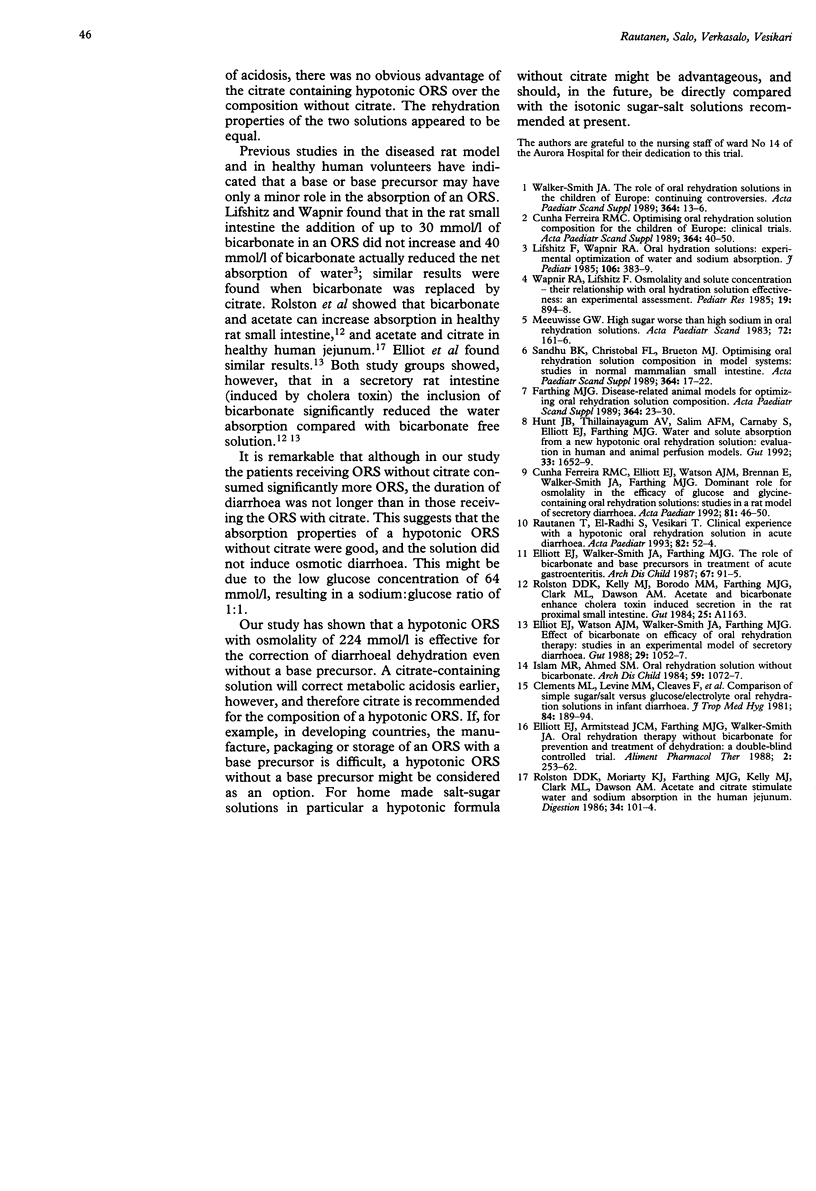Abstract
Hypotonic oral rehydration salts solutions (ORS) have been proved to be better than isotonic solutions with respect to water absorption. To establish whether a base precursor is essential in the composition of a hypotonic ORS with improved absorption properties, a randomised double blind clinical trial was conducted comparing two formulas of hypotonic ORS, each with an osmolality of 224 mmol/l, with or without citrate, in a group of 107 children admitted to hospital with acute diarrhoea. The two solutions were effective in the correction of dehydration and there was no difference between the treatments in the duration of diarrhoea. The patients receiving the hypotonic ORS with citrate consumed less of the solution, however, and their metabolic acidosis was corrected earlier. It is concluded that citrate is clinically advantageous in a hypotonic ORS, but a hypotonic formula without a base precursor is also effective.
Full text
PDF


Selected References
These references are in PubMed. This may not be the complete list of references from this article.
- Clements M. L., Levine M. M., Cleaves F., Hughes T. P., Caceres M., Aleman E., Black R. E., Rust J. Comparison of simple sugar/salt versus glucose/electrolyte oral rehydration solutions in infant diarrhoea. J Trop Med Hyg. 1981 Oct;84(5):189–194. [PubMed] [Google Scholar]
- Cunha Ferreira R. M., Elliott E. J., Watson A. J., Brennan E., Walker-Smith J. A., Farthing M. J. Dominant role for osmolality in the efficacy of glucose and glycine-containing oral rehydration solutions: studies in a rat model of secretory diarrhoea. Acta Paediatr. 1992 Jan;81(1):46–50. doi: 10.1111/j.1651-2227.1992.tb12077.x. [DOI] [PubMed] [Google Scholar]
- Elliott E. J., Armitstead J. C., Farthing M. J., Walker-Smith J. A. Oral rehydration therapy without bicarbonate for prevention and treatment of dehydration: a double-blind controlled trial. Aliment Pharmacol Ther. 1988 Jun;2(3):253–262. doi: 10.1111/j.1365-2036.1988.tb00695.x. [DOI] [PubMed] [Google Scholar]
- Elliott E. J., Walker-Smith J. A., Farthing M. J. The role of bicarbonate and base precursors in treatment of acute gastroenteritis. Arch Dis Child. 1987 Jan;62(1):91–95. doi: 10.1136/adc.62.1.91. [DOI] [PMC free article] [PubMed] [Google Scholar]
- Elliott E. J., Watson A. J., Walker-Smith J. A., Farthing M. J. Effect of bicarbonate on efficacy of oral rehydration therapy: studies in an experimental model of secretory diarrhoea. Gut. 1988 Aug;29(8):1052–1057. doi: 10.1136/gut.29.8.1052. [DOI] [PMC free article] [PubMed] [Google Scholar]
- Farthing M. J. Disease-related animal models for optimising oral rehydration solution composition. Acta Paediatr Scand Suppl. 1989;364:23–30. doi: 10.1111/j.1651-2227.1989.tb11317.x. [DOI] [PubMed] [Google Scholar]
- Hunt J. B., Thillainayagam A. V., Salim A. F., Carnaby S., Elliott E. J., Farthing M. J. Water and solute absorption from a new hypotonic oral rehydration solution: evaluation in human and animal perfusion models. Gut. 1992 Dec;33(12):1652–1659. doi: 10.1136/gut.33.12.1652. [DOI] [PMC free article] [PubMed] [Google Scholar]
- Islam M. R., Ahmed S. M. Oral rehydration solution without bicarbonate. Arch Dis Child. 1984 Nov;59(11):1072–1075. doi: 10.1136/adc.59.11.1072. [DOI] [PMC free article] [PubMed] [Google Scholar]
- Lifshitz F., Wapnir R. A. Oral hydration solutions: experimental optimization of water and sodium absorption. J Pediatr. 1985 Mar;106(3):383–389. doi: 10.1016/s0022-3476(85)80661-2. [DOI] [PubMed] [Google Scholar]
- Meeuwisse G. W. High sugar worse than high sodium in oral rehydration solutions. Acta Paediatr Scand. 1983 Mar;72(2):161–166. doi: 10.1111/j.1651-2227.1983.tb09689.x. [DOI] [PubMed] [Google Scholar]
- Rautanen T., el-Radhi S., Vesikari T. Clinical experience with a hypotonic oral rehydration solution in acute diarrhoea. Acta Paediatr. 1993 Jan;82(1):52–54. doi: 10.1111/j.1651-2227.1993.tb12516.x. [DOI] [PubMed] [Google Scholar]
- Rolston D. D., Moriarty K. J., Farthing M. J., Kelly M. J., Clark M. L., Dawson A. M. Acetate and citrate stimulate water and sodium absorption in the human jejunum. Digestion. 1986;34(2):101–104. doi: 10.1159/000199317. [DOI] [PubMed] [Google Scholar]
- Sandhu B. K., Christobal F. L., Brueton M. J. Optimising oral rehydration solution composition in model systems: studies in normal mammalian small intestine. Acta Paediatr Scand Suppl. 1989;364:17–22. doi: 10.1111/j.1651-2227.1989.tb11316.x. [DOI] [PubMed] [Google Scholar]
- Walker-Smith J. A. The role of oral rehydration solutions in the children of Europe: continuing controversies. Acta Paediatr Scand Suppl. 1989;364:13–16. doi: 10.1111/j.1651-2227.1989.tb11315.x. [DOI] [PubMed] [Google Scholar]
- Wapnir R. A., Lifshitz F. Osmolality and solute concentration--their relationship with oral hydration solution effectiveness: an experimental assessment. Pediatr Res. 1985 Sep;19(9):894–898. doi: 10.1203/00006450-198509000-00004. [DOI] [PubMed] [Google Scholar]
- da Cunha Ferreira R. M. Optimising oral rehydration solution composition for the children of Europe: clinical trials. Acta Paediatr Scand Suppl. 1989;364:40–50. doi: 10.1111/j.1651-2227.1989.tb11319.x. [DOI] [PubMed] [Google Scholar]


